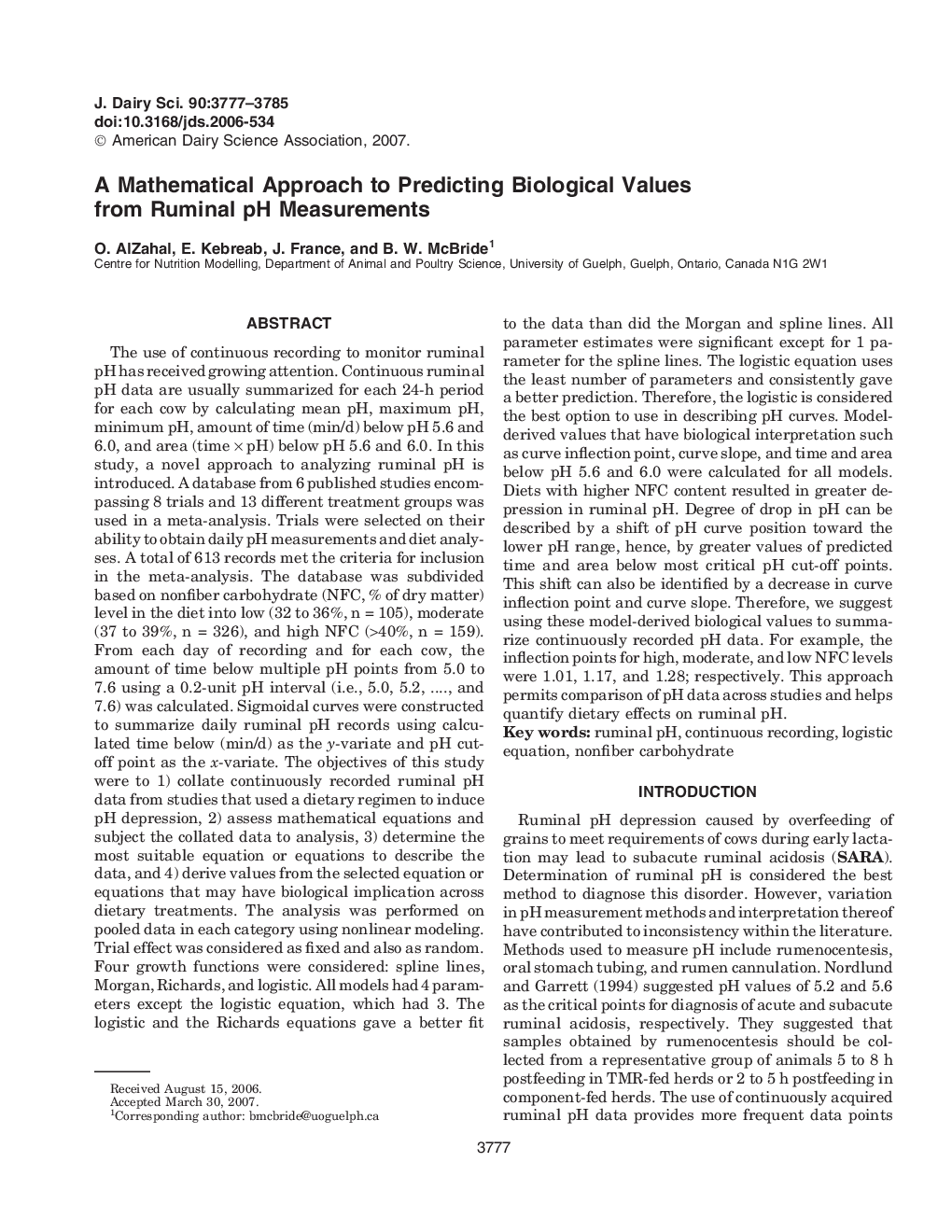| کد مقاله | کد نشریه | سال انتشار | مقاله انگلیسی | نسخه تمام متن |
|---|---|---|---|---|
| 2440458 | 1108118 | 2007 | 9 صفحه PDF | دانلود رایگان |
عنوان انگلیسی مقاله ISI
A Mathematical Approach to Predicting Biological Values from Ruminal pH Measurements
دانلود مقاله + سفارش ترجمه
دانلود مقاله ISI انگلیسی
رایگان برای ایرانیان
کلمات کلیدی
موضوعات مرتبط
علوم زیستی و بیوفناوری
علوم کشاورزی و بیولوژیک
علوم دامی و جانورشناسی
پیش نمایش صفحه اول مقاله

چکیده انگلیسی
The use of continuous recording to monitor ruminal pH has received growing attention. Continuous ruminal pH data are usually summarized for each 24-h period for each cow by calculating mean pH, maximum pH, minimum pH, amount of time (min/d) below pH 5.6 and 6.0, and area (time Ã pH) below pH 5.6 and 6.0. In this study, a novel approach to analyzing ruminal pH is introduced. A database from 6 published studies encompassing 8 trials and 13 different treatment groups was used in a meta-analysis. Trials were selected on their ability to obtain daily pH measurements and diet analyses. A total of 613 records met the criteria for inclusion in the meta-analysis. The database was subdivided based on nonfiber carbohydrate (NFC, % of dry matter) level in the diet into low (32 to 36%, n = 105), moderate (37 to 39%, n = 326), and high NFC (>40%, n = 159). From each day of recording and for each cow, the amount of time below multiple pH points from 5.0 to 7.6 using a 0.2-unit pH interval (i.e., 5.0, 5.2, â¦, and 7.6) was calculated. Sigmoidal curves were constructed to summarize daily ruminal pH records using calculated time below (min/d) as the y-variate and pH cutoff point as the x-variate. The objectives of this study were to 1) collate continuously recorded ruminal pH data from studies that used a dietary regimen to induce pH depression, 2) assess mathematical equations and subject the collated data to analysis, 3) determine the most suitable equation or equations to describe the data, and 4) derive values from the selected equation or equations that may have biological implication across dietary treatments. The analysis was performed on pooled data in each category using nonlinear modeling. Trial effect was considered as fixed and also as random. Four growth functions were considered: spline lines, Morgan, Richards, and logistic. All models had 4 parameters except the logistic equation, which had 3. The logistic and the Richards equations gave a better fit to the data than did the Morgan and spline lines. All parameter estimates were significant except for 1 parameter for the spline lines. The logistic equation uses the least number of parameters and consistently gave a better prediction. Therefore, the logistic is considered the best option to use in describing pH curves. Model-derived values that have biological interpretation such as curve inflection point, curve slope, and time and area below pH 5.6 and 6.0 were calculated for all models. Diets with higher NFC content resulted in greater depression in ruminal pH. Degree of drop in pH can be described by a shift of pH curve position toward the lower pH range, hence, by greater values of predicted time and area below most critical pH cut-off points. This shift can also be identified by a decrease in curve inflection point and curve slope. Therefore, we suggest using these model-derived biological values to summarize continuously recorded pH data. For example, the inflection points for high, moderate, and low NFC levels were 1.01, 1.17, and 1.28; respectively. This approach permits comparison of pH data across studies and helps quantify dietary effects on ruminal pH.
ناشر
Database: Elsevier - ScienceDirect (ساینس دایرکت)
Journal: Journal of Dairy Science - Volume 90, Issue 8, August 2007, Pages 3777-3785
Journal: Journal of Dairy Science - Volume 90, Issue 8, August 2007, Pages 3777-3785
نویسندگان
O. AlZahal, E. Kebreab, J. France, B.W. McBride,